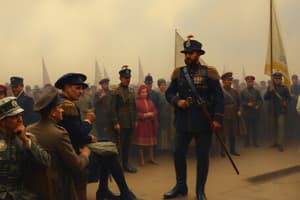Podcast
Questions and Answers
What event triggered the start of World War I?
What event triggered the start of World War I?
- The signing of the Treaty of Versailles
- The assassination of Franz Ferdinand (correct)
- The invasion of Belgium by Germany
- The declaration of war by the United States
Which countries were part of the Allies during World War I?
Which countries were part of the Allies during World War I?
- Italy, Japan, United States
- Spain, Portugal, Greece
- Great Britain, France, Russia (correct)
- Germany, Austria-Hungary, Ottoman Empire
What was one of the main reasons the United States finally entered World War I in 1917?
What was one of the main reasons the United States finally entered World War I in 1917?
- The Treaty of Versailles
- Unrestricted submarine warfare (correct)
- Allied successful battles
- Military expansionism
What was the outcome of the armistice signed on November 11, 1918?
What was the outcome of the armistice signed on November 11, 1918?
What laid the groundwork for World War II after World War I?
What laid the groundwork for World War II after World War I?
Flashcards are hidden until you start studying
Study Notes
Assassination and Outbreak of War
- Assassination of Archduke Franz Ferdinand of Austria-Hungary in April 1914 triggered a series of political crises across Europe.
- The event catalyzed alliances and tensions, leading to the start of World War I.
Major Alliances
- The war involved two main factions:
- Allies: Great Britain, France, and Russia.
- Central Powers: Germany, Austria-Hungary, and the Ottoman Empire.
United States Neutrality
- In 1914, the United States declared neutrality under the Neutrality Act of 1914.
- President Woodrow Wilson sought to keep the U.S. out of the conflict, emphasizing peace and diplomacy.
Factors Leading to U.S. Involvement
- Three critical factors led to the U.S. entering World War I in 1917:
- Unrestricted Submarine Warfare: Germany's policy of attacking merchant vessels without warning, jeopardizing American ships.
- Propaganda Campaigns: Influential campaigns heightened public opinion against the Central Powers.
- Zimmerman Telegram: A secret communication from Germany proposing a military alliance with Mexico against the U.S., which was intercepted and made public.
Shift in War Dynamics
- The entry of the United States into the war in 1917 shifted momentum toward the Allies, enabling a series of victories against the Central Powers.
Conclusion of the War
- An armistice was signed on November 11, 1918, effectively ending hostilities.
- The Treaty of Versailles was signed in 1919, formally concluding World War I and establishing conditions that would contribute to World War II.
Studying That Suits You
Use AI to generate personalized quizzes and flashcards to suit your learning preferences.




